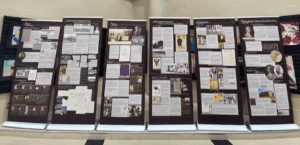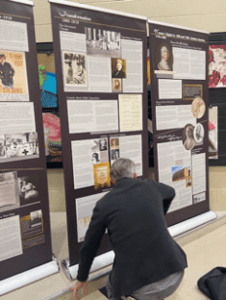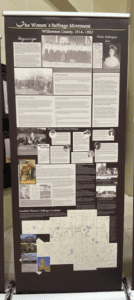In 1920, the United States Congress passed the Nineteenth Amendment, and for the first time, granted many women the right to vote. As a part of our educational initiatives through the ongoing commemoration of the Suffrage Centennial, our education team created our first interpretive traveling exhibit currently making its way throughout the county in 2021 to tell the story of Williamson County and Tennessee women’s activism tied to women’s suffrage.

Hear Our Voices: Lives and Legacies of the Women’s Suffrage Movement interpretive traveling exhibit on display at Ravenwood High School. Image courtesy of the Heritage Foundation of Williamson County.
We are thrilled to announce our first ever interpretive panel traveling exhibit, Hear Our Voices: Lives and Legacies of the Women’s Suffrage Movement, is moving around to our Williamson County High Schools! The evolution of our interpretive exhibit was not a typical exhibit development process. Traditionally, historic organization’s museum exhibits develop through artwork, objects, photographs, or documents curators and exhibit designers want to feature, with the exhibit evolution progressing to tell the larger story about the selected pieces. Since our exhibit does not follow a traditional arch, we wanted our exhibit to showcase powerful storytelling, illuminated by over two hundred years of determination – the origins of freedom, suffrage, and the women’s rights movement, including local women, tied to the state and national stories. In doing so, the “objects” we selected for interpretive panels were their own words – their voices – from their letters and speeches as well as their photographs and places.
Our education team began a nine-month journey with several questions in mind – Who should we include, locate, and depict in this exhibit? What images best illustrate the push-pull for women’s suffrage locally, regionally, and nationally? Could digital engagement be contextually conveyed by providing online sources as a component of the text? How intentional should we be with our design selection of the background colors for all panels? How should we contextually weave the multiple stories of the selected women to clearly convey their voices?
While our final product begins with the American Revolution and ends with the legacies of the suffrage movement, our development process began with our team and a rather large dry erase board, brainstorming themes, and periods of significance. We then set out to create a spreadsheet of women whose powerful stories we believed would resonate throughout the exhibit. Our team recognized researching the national and regional stories would be relatively straightforward. However, the local history, we thought, was non-existent. But we did not let that deter us. Instead, we let it motivate and shape our approach to identifying how the national story informed the local story, especially on the ideals of what it meant to be a woman, a voter, and a citizen. We also wanted women’s voices connected to the suffrage movement to make a statement throughout the exhibit. While our team was always striving to incorporate a diverse group of women into the interpretive exhibit, we always referred back to who would be our audience – students, educators, and community members. This audience seeks to have a better understanding of our local history tied to the national history.
Utilizing the extensive manuscript and online collections at the Williamson County Archives, the Tennessee State Library and Archives, the James Walker Library at Middle Tennessee State University’s Special Collection, we researched through the ever-growing universe of historical documents and publications. Digitally, the Library of Congress, the National Archives, and the National Park Service afforded us numerous documents that allowed our team to pour over handwritten letters, essays, newspapers, and speeches to develop the narrative for the national story. In researching the local suffrage movement, we combed through local newspapers, family files, maps, local publications, and voter registrations. What we discovered was a dynamic, local movement between white and black women who knew how to organize, mobilize, and energize their communities.

Director of Preservation and Education Blake Wintory, PhD, setting up the panels at Ravenwood High School. Image courtesy of the Heritage Foundation of Williamson County.
While we always knew the exhibit would span the earliest days of the American Revolution, to present day, we also wanted to focus on the roles of our modern day local, Tennessee women as community activists, leaders, and politicians. We went through several rounds of outline drafts, posting questions for each thematic panel and sorted questions our team believed required answers. Throughout the entire process, the numerous voices of known and unknown women we incorporated into this exhibit spoke volumes to their inherent desires to have a voice at the ballot box.
While many people know about Susan B. Anthony and Ida B. Wells as pillars of the suffrage movement, that may not know their backgrounds and events that propelled them to the national spotlight. For the lesser-known women, especially in Franklin and Williamson County, we wanted to convey women’s movements in town by mapping the various places, including hotels, private homes, and churches, women gathered and mobilized for suffrage.

As a component of our exhibit, there is a panel focused solely on women in Franklin and Williamson County. Image courtesy of the Heritage Foundation of Williamson County.
We are fortunate to have talented staff who adeptly designed the exhibit and chose colors and fonts that visually communicate the exhibit. The fonts selected subtly appear throughout the text when appropriate to the time periods. While we had an enormous amount of primary and secondary sources available to us, there remained limitations to the accessibility of local African American women primary and secondary sources. After months of research and several rounds of writing, marking up copy, multiple revisions and countless edits, the thrill of seeing the fully produced exhibit panels was truly overwhelming and rewarding. Our team personally transported the exhibit to its first destination, Ravenwood High School, and discuss the exhibit with the administration, educators, and students. In the next three weeks, the exhibit panels will travel to several other high schools including Centennial and Summit. Over the summer, the exhibit will be traveling to libraries and the Williamson County Archives.
One of the most important take away is that the struggle concerning women’s disenfranchisement began with the founding of the county, continuing today. For all of its commemorative significance, the Nineteenth Amendment did not enfranchise all American women. Millions had at least partial suffrage prior to 1920, however; millions more faced discrimination and voter disenfranchisement from the polls after 1920. Many barriers to votes for women (and even men) remain even today. Another crucial takeaway from the exhibit is knowing suffragists represented every demographic group in our nation. The struggle for women’s suffrage included white and black women, women of Hispanic and Asian descent as well as American Indian. It included immigrant as well as native born, working and middle-class women as well as the socio-economic elite. The women’s suffrage movement was every woman’s movement.
We are eager to engage with students, educators, and our community in multiple venues where the exhibit will be displayed, learn visitors’ responses, and have meaningful dialogue around a historically significant movement in our history.
To learn more about our education initiatives and programming, please contact Senior Director of Preservation and Education Rachael Finch at rfinch@williamsonheritage.org.